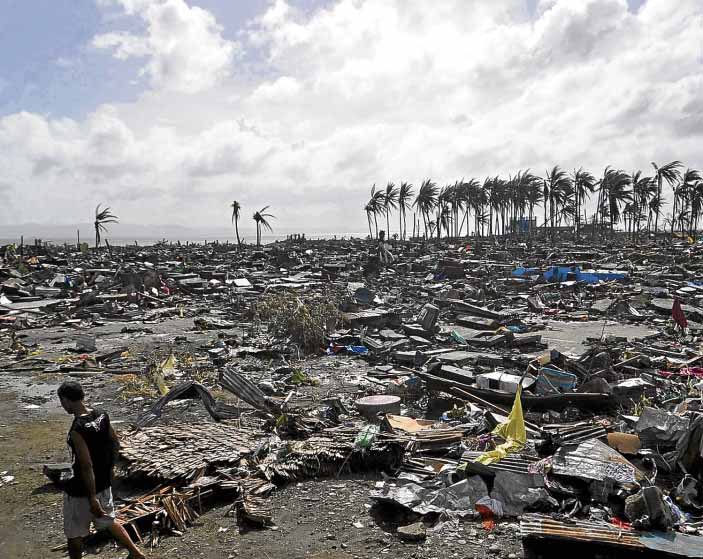
GROUND ZERO “Yolanda” flattened this portion of Tacloban City, ground zero for the 2013 supertyphoon that swept the Visayas. —RICHARD A. REYES
The onslaught of tropical cyclones, heat waves, droughts and storm surges in Southeast Asia has become more frequent and severe in recent years—a phenomenon attributed to the significant warming of the planet.
The high concentration of population and economic activities along its coastlines makes the region extremely vulnerable to climate change.
According to a report released by the Asian Development Bank in 2009, the average temperature in the region increased by 0.1 to 0.3 degree Celsius per decade between 1951 and 2000; sea levels in the region rose 1 to 3 millimeters per year; and rainfall trended downward from 1960 to 2000.
Other multifaceted impact of climate change throughout the region is outlined in the Assessment Reports of the Intergovernmental Panel on Climate Change.
It is therefore imperative for the Association of Southeast Asian Nations (Asean) to play an active role in global climate change negotiations, a responsibility it has assumed in the past years by releasing joint declarations and statements expressing the group’s common understanding, position and aspirations toward a global solution to climate change.
Joint statement
The Philippines, as the incumbent chair of Asean, shall carry on this leadership by delivering the Asean Joint Statement on Climate Change (AJSCC) during the high-level segment of the 23rd Conference of the Parties to the United Nations Framework Convention on Climate Change (UNFCCC) in Bonn, Germany.
The 2017 AJSCC is expected to reaffirm Asean’s commitment to the UNFCCC, the Paris Agreement and the principle of common but differentiated responsibilities and respective capabilities.
Moreover, it shall serve as a policy guide on how the regional bloc could increase the resilience of its communities and lessen the impact of climate change on the region’s economy.
While Asean has various strategies, policies and programs in place to address climate change, an apparent linkage for all these remains to be established.
Hence, there is a need for the bloc to develop an inclusive and encompassing regional climate action blueprint—one that also articulates the need for Asean leaders to put climate action at the center of its national programs and policies in order to sustain the economic gains of the region over the next years.
Key actions
The envisioned Asean climate action blueprint must outline specific solutions for building the adaptive capacity of its communities. At the outset, here are some key actions that must be taken into consideration for the development of this document:
Development of low-carbon and resilient infrastructure assets. Asean must strive to create a financial environment that encourages the development of low-carbon and climate-resilient critical infrastructure projects for power generation, energy efficiency, urban transport systems, solid waste management, etc.
In order to do this, Asean should champion the establishment of financial instruments to mobilize private sector involvement and to de-risk investments for greening the region’s infrastructure.
Promoting the sustainable management of ecosystems. As a strong forestry bloc, Asean’s climate action blueprint must also communicate the need to increase the resilience of its natural ecosystems to climate change.
Promoting sustainable management of ecosystems will contribute to reducing emission from deforestation and forest degradation, and to the enhancement of the region’s carbon sink capacity.
Emergency response
Strengthening the capacity of the region to respond to disasters. Given the extreme vulnerability of the region to natural disasters, Asean should work on strengthening the capacity of member countries for disaster management and emergency response through existing mechanisms under the Asean Agreement on Disaster Management and Emergency Response.
In addition to knowledge sharing and technology transfer among member-states, the strengthening of the operations of the Asean Coordinating Center for Humanitarian Assistance on Disaster Management must also be ensured.
Pursuing climate-smart agriculture approaches to ensure food security. Recognizing the important role of agriculture in ensuring long-term food security in the region, Asean must facilitate the development of adaptation measures in areas where it is of high priority.
Strategic plan of action
The implementation of the Strategic Plan of Action on Food Security in the Asean Region (2015-2020) must be completed, as this provides the groundwork for strengthening the following components of climate-smart agriculture: shortage relief, sustainable food trade, integrated food security information system and agricultural innovation.
Throughout the years, the effective and efficient multilateral cooperation among Asean member-states has been evident in the region’s impressive economic performance and social progress. This indicates the power of the regional bloc to make a real impact in combating the impact of climate change as long as it stands united.
In order to operationalize and implement its own climate action blueprint, Asean should demonstrate political will in integrating climate change adaptation and mitigation in all its regional policies and economic planning frameworks.
Likewise, the group must also be relentless in pushing for Annex I countries of the UNFCCC to provide financial support for developing countries to undertake emissions reduction and adaption activities.